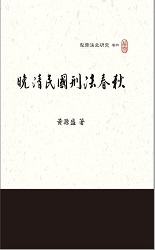Only available in Chinese.
*****
法史學研究的範圍究竟該含蓋多廣,可能言人人殊,理想上,至少宜包括法律規範、法律制度、法律思想、法律意識與司法實踐等各個層面,並側重在觀察法律歷史發展過程中的常與變。而在具體的探討中所觀照的面向,一在史實的重建,一在歷史現象的探因與詮釋。前者指的是法律歷史的「現象世界」,即「當時的法規範是什麼?」後者則是法律歷史的「根源世界」與「意義世界」,即「法制歷史的發展為什麼是如此?」以及「法制發展歷史現象背後所蘊涵的意義到底為何?」
長年以來,我總覺得,完整而深刻的法史學研究,離不開史料、史實與史論三部曲;沒有史料就沒有歷史,既不能忽略基本史料的辨證與整建,以追求對於過往法律生活現象最大程度的客觀呈現;同時,也要致力於法律歷史發展動因的探尋,以了解其所以然的因素,乃至聯想起歷史的過去、現在與未來,進而達到知其所應然的境地。可以說,現象世界的重現,是法史學研究的起點,也為一切推論與評價的基石。
泛泛說來,台灣現行的六法體制架構與源起,絕大部分肇端於晚清民初乃至國民政府時期的法律繼受工程,惟該段法制歷史,囿於種種因緣,在海內外法史學的研究上,曾經長期埋在荒煙蔓草中,縱使少數人有意耕耘,也只能作些零散式的探勘。為了填補罅漏,個人於1998至2004年間,曾多次遠赴海內外各地,蒐集北洋政府時期(1912-1928)和國民政府時期(1928-1948)的司法裁判史料,經過十多年的整編,《平政院裁決錄存》、《大理院民事判例輯存》、《大理院刑事判例輯存》、《最高法院判例輯存》(民事編、刑事編)等共二三大冊已陸續刊行於世。
在司法檔案整編告一段落後,深感立法規範與司法實踐本為體用關係,研究裁判文書,不能輕忽同一時期的相關立法史料;蓋唯有將立法文獻與司法審判檔案兩相對照,才能洞察規範「應然面」與審判「實然面」間所存在的落差,以期精確掌握法制發展的真實面貌,也才能給予中肯的解析與詮釋,為此,最近幾年,又將關注的重點轉移到立法史料上面。
欣慰的是,透過多番的梳理過程,對於如何蒐集、整理及校注法制史料文獻,已獲得精實的寶貴經驗。之前整編的成果《晚清民國刑法史料輯注》一書,大致得以窺見清末民國刑法變遷的整體輪廓。而在纂輯裁判文書與立法規範的同時,也不忘進行實質內容的研究,邊寫邊發表於國內外學術期刊,如今積稿已儼然可成冊,乃重加增損分合,付梓問世,希望這些史料的現形、史實的建構、義理的闡明,能提供有心人進行立說時,益加貼近歷史事實,避免主觀臆測,而對於當今的立法及司法實務界檢討法制興革時,或可提供一隅之得。
歷史證明,過去與當代並非完全的「對立」與「斷裂」;其實,於今看來,一部百年刑法史具有很高的連續性與積累性,更有數不盡前賢的智慧在其中。晚清、南京臨時政府、北洋政府、國民政府與當今民國台灣之間一線牽,這一以貫之的「線」似無法由滄桑的政權輪替所任意切割,它是一種思想、一種傳承;薪盡而火傳,傳的是法之「意」,而不是有「形」之薪,然乎?否乎?
而本書之所以名為「刑法春秋」,一來係指歲月、光陰的遷移,以明一世紀以來社會變遷與刑法轉型的嬗遞歷程,〈寒山詩〉有云:「倏爾過春秋,寂然無塵累。」另者,不無隱寓筆則筆、削則削,以效「一字褒貶」的微言要義;前年,與梁慧星教授同訪嶺南古村,先生觀景生情,即興吟賦七律一首相贈,最後兩句為「勸君高擎董狐筆,散帙絕編細鉤沈」,期許何等之深,雖不能至,猶當隨緣而為。
記得小時候,常聽年長者講「萬般因緣」這個詞,那時不懂,而今,已漸能粗解其義,一切事物因緣生、因緣滅。多年來,外雙溪犁齋門前,時而風清景靜,時而雲煙繚繞,而枝頭那三五隻國寶級的台灣藍鵲依舊如來如去;樹上那一群無憂無慮的松鼠總是自由自在地迂迴攀爬,園圃裡種的蔬果大半分給蟲鳥吃了。常有人問起,為什麼總愛好山居歲月,應之曰:
君問何事棲溪山 門對千峰意自閑
書藏萬卷心常空 別有觀音斜陽邊
匆匆,耳順之年已過,雖稍能體悟「過去心不可得、現在心不可得、未來心不可得」,「一切有為法,如夢幻泡影,如露亦如電」,卻還是未能放下世間法的羈絆,這難道是人性中的「癡」?何時才能真正「無所住」而寫?是為序。
